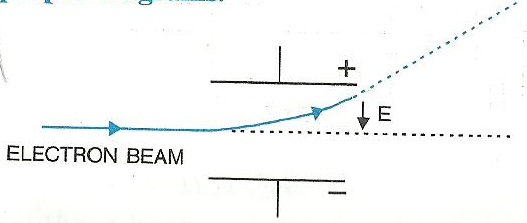ICSE Class 10 Answered

The electrons being negatively charged, experience a force in the electric field and get deflected towards the positive plate as shown in the figure. The path is parabolic within the electric field. On emergence from the electric field, they travel in a straight path along tangent to the parabola at the point of emergence.
In a magnetic field, the electrons experience a force, the direction of which is given by Fleming's left hand rule (i.e., in a direction perpendicular to both the direction of motion of electrons and the direction of magnetic field), so they get deflected in the direction of force and follow a circular path. In this figure, the magnetic field is perpendicular to the plane of paper inwards and is represented by X. On entering the magnetic field, the electron beam is deflected downwards in the plane of paper and follows a circular path. On emergence from the magnetic field, it travels in a straight path along tangent to the circle at the point of emergence.

It is to be mentioned here that (i) there is no force on the electron beam (i.e., the electrons remain undeflected) if the magnetic field is in the direction of motion of electrons, whereas the electron beam gets accelerated or retarded (although remain undeflected) if the electric field is in direction of motion of electrons. (ii) the speed of electron changes in the electric field, but there is no change in speed of electron in the magnetic field.

